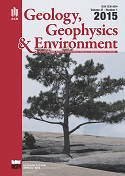Multivariate paleoecological analyses of Badenian and Sarmatian molluscan assemblages from the NW Vienna Basin (Rohožník-Konopiská, Slovakia)
DOI:
https://doi.org/10.7494/geol.2015.41.1.80Keywords:
Vienna Basin, Badenian, Sarmatian, molluscan assemblages, paleoecologyAbstract
Middle Miocene marine sediments in the Vienna Basin provide opportunities for analyses of spatial and temporal variation in the composition of molluscan communities, especially across the Badenian/Sarmatian boundary. In this study, we describe variation in composition of molluscan assemblages with multivariate analyses (cluster and ordination analyses). In ongoing analyses, we test whether Badenian and Sarmatian assemblages (distinguished on the basis of foraminiferal assemblages) significantly differ in their taxonomic and life habit composition.
We focus on a unique set of samples recovered by 80 closely-located borehole cores in 1963 near Rohoznik-Konopiska (Rohalová and Hash 2000), penetrating to ~30-100 m depth in the western part of Slovakia. These cores capture sediments of the Studienka (Badenian) and Halic (Sarmatian) formations that consist of clays, sands and silts. Čierna (1974) studied foraminiferal assemblages in these cores and found that they correspond mainly to the Upper Badenian and Sarmatian. The boundary between the Badenian and Sarmatian sediments is located at ~~206 m.a.s.l. in the SW part and at ~~180 m.a.s.l. in the NE part of the study area. Diverse molluscan assemblages in this area were described by Švagrovský (1971, 1981), Mesároš (1986) and Hladilová (1991).
A well preserved shelly material from 80 borehole cores of Rohožník contains presently more than 6000 individuals (mainly of Badenian age), with ongoing screening of additional samples. They correspond to 156 gastropod, bivalve, and scaphopod taxa at species and genus-level resolution. 72 samples were subjected to preliminary multivariate analyses. A cluster analysis is based on a Bray-Curtis distance and square-root transformed proportional abundances. Ordination analyses are represented by non-metric multidimensional scaling and by principal coordinate analysis.
The cluster analysis discriminated five major sample groups with a recurrent taxonomic composition, although ordination analyses show that some of these groups do not form discrete clusters in a multivariate space but rather continuously grade into each other. Mohrensternia sp and Bittium reticulatum are dominant in the first group. These taxa represent herbivorous euryhaline gastropods, who preferred muddy bottoms (Švagrovský, 1971; Kowalke and Harzhauser, 2004). Nassarius illovensis, Acteocina lojankeriana, Nuculana fragilis and Clithon pictus dominate in the second group. N. fragilis represents an infaunal, mobile, asiphonate deposit-feeder, gastropods are represented by mobile taxa with different food requirements that lived in photic zone (Leonard-Pingel et al., 2012). The third group is dominated by Corbula gibba and Nucula nucleus. C. gibba and N. nucleus represented opportunistic bivalve species that indicate unstable habitats with muddy bottoms, frequently characterized by low-oxygen concentrations and by organic enrichment (Holmes 2002; Hrs-Brenko 2006; N´Siala et al. 2008). The fourth group is dominated by Alvania curta, accompanied with Amalda gladiformis, Cerithium europaeum, and by Aporrhais pespelecani and Acanthocardia turonica that occur exclusively in the Badenian (Harzhauser et Piller 2007; Studencka et Popov 1996). A. turonica prefers sandy bottom, gastropods are represented by herbivore taxa (Švagrovský 1981, Studencka 1986). The fifth group can be characterized as Diloma and Cerithium-dominated association. It mainly consists of gastropods. Diloma occurs in sandy littoral environments (Kroh and Harzhauser, 1999). This discrimination of samples fits with the result of principal coordinate analysis where these taxa group similarly.
Associations of molluscs indicate that sedimentation occurred in the photic zone because the determined molluscs predominantly occupied to shallow subtidal environments. The high abundance of Corbula gibba and Nucula nucleus shows a possibility of stratification of water column, with low content of O2 on the bottom. Some samples in the uppermost parts of cores imply brachyhaline conditions.
Downloads
Downloads
Published
Issue
Section
License
Authors have full copyright and property rights to their work. Their copyrights to store the work, duplicate it in printing (as well as in the form of a digital CD recording), to make it available in the digital form, on the Internet and putting into circulation multiplied copies of the work worldwide are unlimited.
The content of the journal is freely available according to the Creative Commons License Attribution 4.0 International (CC BY 4.0)










